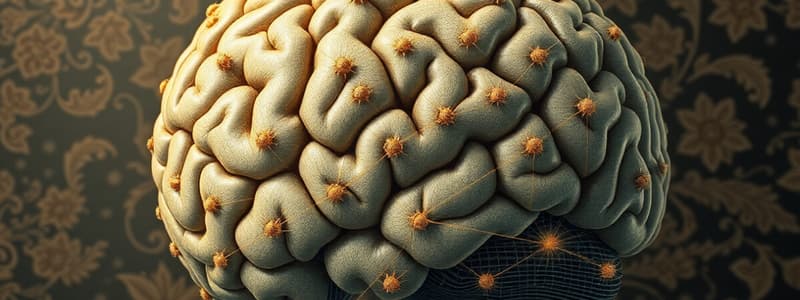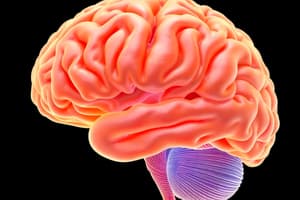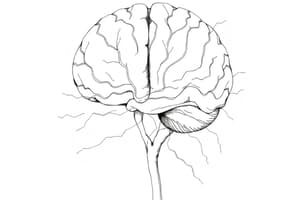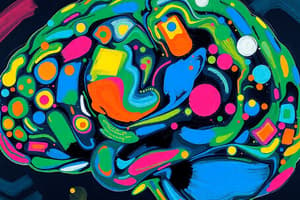Podcast
Questions and Answers
What role does the corpus amygdaloideum primarily play in response to external stimuli?
What role does the corpus amygdaloideum primarily play in response to external stimuli?
- It evaluates and expresses emotions. (correct)
- It mediates rational thought.
- It generates involuntary muscle movements.
- It processes olfactory sensations.
Which structure is directly connected to the limbic system and involved in olfactory processing?
Which structure is directly connected to the limbic system and involved in olfactory processing?
- Claustrum
- Fasciculus uncinatus
- Corpus amygdaloideum (correct)
- Substantia nigra
What might occur if the nucleus subthalamicus is damaged?
What might occur if the nucleus subthalamicus is damaged?
- Inhibition of emotional evaluation.
- Loss of vision and hearing.
- Contralateral hemiballismus. (correct)
- Induced Parkinson's disease.
Which of the following structures is known for housing melanin pigment?
Which of the following structures is known for housing melanin pigment?
What characterizes the communication between the cortex cerebri and basal ganglia?
What characterizes the communication between the cortex cerebri and basal ganglia?
What role do the nuclei basales primarily play in motor function?
What role do the nuclei basales primarily play in motor function?
Which structure is considered the largest of the basal ganglia?
Which structure is considered the largest of the basal ganglia?
What are the sections of the nucleus caudatus?
What are the sections of the nucleus caudatus?
Which structure is located on the outer side of the nucleus caudatus?
Which structure is located on the outer side of the nucleus caudatus?
What is one of the functions of the globus pallidus?
What is one of the functions of the globus pallidus?
Which type of information does the nucleus caudatus integrate?
Which type of information does the nucleus caudatus integrate?
Where is the corpus amygdaloideum located?
Where is the corpus amygdaloideum located?
Which structure is separated from the putamen by the capsula externa?
Which structure is separated from the putamen by the capsula externa?
Flashcards
What are basal ganglia?
What are basal ganglia?
A group of interconnected nuclei located within the white matter of the brain's hemispheres.
What is the main function of basal ganglia?
What is the main function of basal ganglia?
They play a crucial role in coordinating complex movements, initiating voluntary actions, and maintaining posture during those actions.
Describe the caudate nucleus.
Describe the caudate nucleus.
It's the largest of the basal ganglia and is divided into three parts: the head, body, and tail. It forms a functional unit with the putamen called the neostriatum.
What are the inputs and outputs of the caudate nucleus?
What are the inputs and outputs of the caudate nucleus?
Signup and view all the flashcards
Describe the lentiform nucleus.
Describe the lentiform nucleus.
Signup and view all the flashcards
What are the inputs and outputs of the putamen?
What are the inputs and outputs of the putamen?
Signup and view all the flashcards
Describe the amygdala.
Describe the amygdala.
Signup and view all the flashcards
Describe the inputs and outputs of the globus pallidus.
Describe the inputs and outputs of the globus pallidus.
Signup and view all the flashcards
What is the Amygdala's role in emotion?
What is the Amygdala's role in emotion?
Signup and view all the flashcards
What is the role of Fasciculus Uncinatus?
What is the role of Fasciculus Uncinatus?
Signup and view all the flashcards
Where is the Claustrum located and what is its function?
Where is the Claustrum located and what is its function?
Signup and view all the flashcards
How do the Pyramidal and Extrapyramidal Systems differ?
How do the Pyramidal and Extrapyramidal Systems differ?
Signup and view all the flashcards
What is the Substantia Nigra and what happens when it is damaged?
What is the Substantia Nigra and what happens when it is damaged?
Signup and view all the flashcards
Study Notes
Nuclei Basales
-
Nuclei basales are masses of gray matter formed by groups of neurons within the substantia alba of the cerebrum
-
These structures are hidden within the substantia alba encephali, making them difficult to view without cerebral sectioning.
-
They are also known as subcortical nuclei of the telencephalon.
-
Nuclei basales play a crucial role in the coordination of motor movements, initiation of voluntary movements, and posture control associated with voluntary movements.
-
Three fundamental tasks of basal ganglia include:
- Controlling complex motor activities (e.g., writing, using scissors, sports)
- Controlling sequential motor movements and integrating information from memory and performing tasks
- Controlling speed and magnitude (number of steps and distance) of movements
Components of Nuclei Basales
-
Nucleus caudatus: The largest basal ganglion, divided into caput, corpus, and cauda sections.
- Works together with the putamen to form the neostriatum, a functional unit
- Afferent connections: cortex cerebri, thalamus, substantia nigra, corpus amygdaloideum
- Efferent connections: globus pallidus, substantia nigra
- Located below the lateral ventricles, above the thalamus
-
Nucleus lentiformis: Located on the outer side of the nucleus caudatus and thalamus
- Composed of putamen (outer part) and globus pallidus (inner part)
- The putamen is separated from the claustrum by the capsula externa
- The globus pallidus is separated from the nucleus caudatus by the crus anterius capsula internae; and from the thalamus by the crus posterius capsula internae
- Afferent connections: neostriatum, subthalamic nucleus, substantia nigra
- Efferent connections: thalamus, subthalamic nucleus
-
Corpus amygdaloideum: Almond-shaped structure located at the anterior end of the temporal horn of the lateral ventricle
- Plays a major role in emotion formation and processing within the limbic system
- Receives external stimuli after the primary sensory cortex
- Associates stimuli with positive and negative emotions from memory
- Involved in emotional evaluation and expression
-
Claustrum: Located beneath the insula cortex; separated from the cortex cerebri by the capsula extrema, and from the putamen by the capsula externa
- Connected to cortical centers, such as vision and audition (hearing)
Other Information
-
Descending pathways originating from the cerebral cortex are part of the pyramidal system; basal ganglia pathways are part of the extrapyramidal system.
-
The subthalamic nucleus is located at the dorsal lateral part of the upper end of the substantia nigra. Damage to this area can cause contralateral hemiballismus (involuntary, severe shaking and jumping movements).
- Afferent connections: globus pallidus
- Efferent connections: globus pallidus, substantia nigra
-
The substantia nigra is a core component of the mesencephalon (midbrain), dark-colored due to melanin pigment
- Dysfunction leads to Parkinson's disease
- Afferent connections: neostriatum
- Efferent connections: neostriatum, thalamus, superior colliculus
-
The cerebral cortex and basal ganglia exhibit extensive communication networks. This allows the basal ganglia to influence structures in the brainstem and spinal cord where there is no direct connection.
-
The fasciculus uncinatus connects the frontal lobe to the limbic system enabling the integration of rational thought with emotional processing; and directly connects the limbic system to the olfactory bulb for sensory processing.
Studying That Suits You
Use AI to generate personalized quizzes and flashcards to suit your learning preferences.




